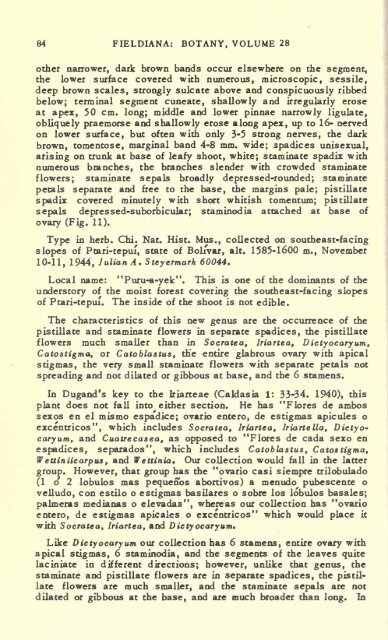PDF - University Library
PDF - University Library
PDF - University Library
Create successful ePaper yourself
Turn your PDF publications into a flip-book with our unique Google optimized e-Paper software.
84 FIELDIANA: BOTANY, VOLUME 28<br />
other narrower, dark brown bands occur elsewhere on the segment,<br />
the lower surface covered with numerous, microscopic, sessile,<br />
deep brown scales, strongly sulcate above and conspicuously ribbed<br />
below; terminal segment cuneate, shallowly and irregularly erose<br />
at apex, 50 cm. long; middle and lower pinnae narrowly ligulate,<br />
obliquely praemorse and shallowly erose along apex, up to 16- nerved<br />
on lower surface, but often with only 3-5 strong nerves, the dark<br />
brown, tomentose, marginal band 4-8 mm. wide; spadices unisexual,<br />
arising on trunk at base of leafy shoot, white; staminate spadix with<br />
numerous branches, the branches slender with crowded staminate<br />
flowers; staminate sepals broadly depressed-rounded; staminate<br />
petals separate and free to the base, the margins pale; pistillate<br />
spadix covered minutely with short whitish tomentum; pistillate<br />
sepals depressed-suborbicular; staminodia attached at base of<br />
ovary (Fig. 11).<br />
Type in herb. Chi. Nat. Hist. Mus., collected on southeast-facing<br />
slopes of Ptari-tepuT, state of Bolivar, alt. 1585-1600 m., November<br />
10-11, 1944, Julian A. Steyermark 60044.<br />
Local name: "Puru-a-yek". This is one of the dominants of the<br />
understory of the moist forest covering the southeast-facing slopes<br />
of Ptari-tepuT. The inside of the shoot is not edible.<br />
The characteristics of this new genus are the occurrence of the<br />
pistillate and staminate flowers in separate spadices, the pistillate<br />
flowers much smaller than in Socratea, Iriartea, Dictyocaryum,<br />
Catostigma, or Catoblastus, the entire glabrous ovary with apical<br />
stigmas, the very small staminate flowers with separate petals not<br />
spreading and not dilated or gibbous at base, and the 6 stamens.<br />
In Dugand's key to the Iriarteae (Caldasia 1: 33-34. 1940), this<br />
plant does not fall either section. into^<br />
He has "Flores de ambos<br />
sexos en el mismo espa'dice; ovario entero, de estigmas apicules o<br />
excentricos", which includes Socratea, Iriartea, Iriartella, Dictyocaryum,<br />
and Cuatrecasea, as opposed to "Flores de cada sexo en<br />
espadices, separados", which includes Catoblastus, Catostigma,<br />
Wettiniicarpus, and Wettinia. Our collection would fall in the latter<br />
group. However, that group has the "ovario casi siempre trilobulado<br />
(1 o 2 lobulos mas pequenbs abortivos) a menudo pubescente o<br />
velludo, con estilo o estigmas basilares o sobre los lobulos basales;<br />
palmeras medianas o elevadas", whereas our collection has "ovario<br />
entero, de estigmas apicales o excentricos" which would place<br />
it<br />
wkh Socratea, Iriartea, and Dictyocaryum.<br />
Like Dictyocaryum our collection has 6 stamens, entire ovary with<br />
apical stigmas, 6 staminodia, and the segments of the leaves quite<br />
laciniate in different directions; however, unlike that genus, the<br />
staminate and pistillate flowers are in separate spadices, the pistillate<br />
flowers are much smaller, and the staminate sepals are not<br />
dilated or gibbous at the base, and are much broader than long. In










![Novellen [microform] - University Library](https://img.yumpu.com/21939450/1/171x260/novellen-microform-university-library.jpg?quality=85)
![Anecdota Chisiana de re metrica [microform]](https://img.yumpu.com/21939448/1/190x239/anecdota-chisiana-de-re-metrica-microform.jpg?quality=85)



![Schollenbruch [microform] : Gedichte - University Library](https://img.yumpu.com/21939437/1/174x260/schollenbruch-microform-gedichte-university-library.jpg?quality=85)
